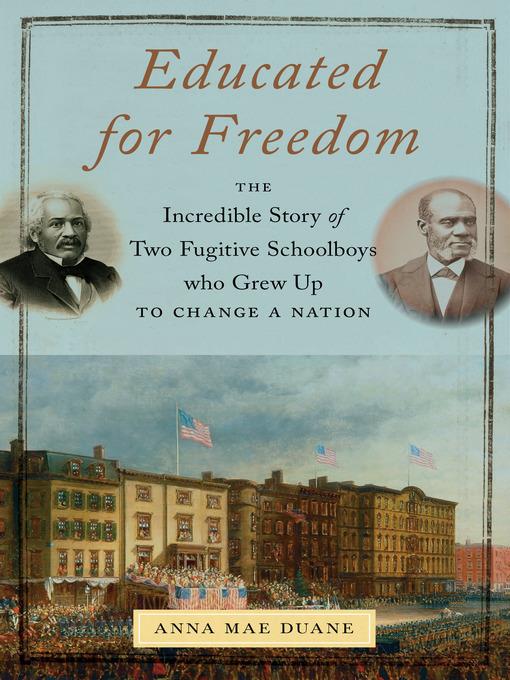
Educated for Freedom
The Incredible Story of Two Fugitive Schoolboys Who Grew Up to Change a Nation
- اطلاعات
- نقد و بررسی
- دیدگاه کاربران
نقد و بررسی

October 15, 2019
An overlooked story of two important African Americans who impacted the slavery debate at a critical moment in American history. Many historians focus on Nat Turner, Harriet Tubman, Frederick Douglass, Sojourner Truth, and Mary Church Terrell as the leading African American civil rights advocates of the 19th century. Yet Duane (English/Univ. of Connecticut; Suffering Childhood in Early America: Violence, Race, and the Making of the Child Victim, 2017, etc.) reminds us of two critical black leaders who influenced the national civil rights debate and symbolized the era's frustrating potential: James McCune Smith (1813-1865) and Henry Highland Garnet (1815-1882). Smith and Garnet met as boys at a New York school and grew to be both friends and rivals, achieving unprecedented honors in a society that viewed black Americans as inherently inferior. Smith graduated first in his class at the University of Glasgow in Scotland, and he was the first African American to hold a medical degree and the first to run a pharmacy. His approach to the abolitionist movement was to collaboratively support and work within institutions expanding freedom, often relying on his medical expertise to refute assertions of black inferiority. By contrast, the fiery Garnet used a combative approach as a minister to advocate a kind of black nationalism that, at times, embraced separating black and white Americans as the only way to achieve true freedom. Garnet acquired a reputation as perhaps the most eloquent black orator of the time, outpacing even Douglass in the eyes of many. Duane departs from the traditional biographical format--surveying from childhood to adulthood--and instead weaves biographical events together through a focus on documents at the school Garnet and Smith attended as children. The result creates a provocative tie between their childhood challenges and the work they pursued as adults. A compelling tale of two boys and their struggle to forge a path for freedom out of a slave nation.
COPYRIGHT(2019) Kirkus Reviews, ALL RIGHTS RESERVED.

Starred review from November 1, 2019
In this dual biography, Duane (English & American Studies, Univ. of Connecticut; Child Slavery Before and After Emancipation) tells the stories of James McCune Smith (1813-65)and Henry Highland Garnet (1815-82). These men led remarkable lives at a time when opportunities for African Americans, even free northerners, were severely circumscribed. Both men attended and formed a lifelong, but at times troubled, friendship at the New York African Free School (NYAFS), a unique school founded in 1787. After graduation, Smith earned a medical degree from Edinburgh University, becoming the first African American to do so. Garnet served as a minister around the country and abroad. Both men found themselves on different sides of the debate about whether African Americans could find a fulfilling place in American society, as Smith believed, or if they could only advance by emigrating from a country that did not want them and settle elsewhere--in Africa, the Caribbean, or South America, as Garnet suggested. Based on extensive archival research, Duane paints a detailed and nuanced picture of black education, including its possibilities and limitations, in the antebellum North. VERDICT A must-read for those interested in antebellum African American life and education.--Chad E. Statler, Westlake Porter P.L., Westlake, OH
Copyright 2019 Library Journal, LLC Used with permission.

February 3, 2020
University of Connecticut English professor Duane (Suffering Childhood in Early America) casts a revealing dual biography of James McCune Smith (1813–1865) and Henry Highland Garnet (1815–1882) against the backdrop of early-19th-century debates over the future of black people in America. Born into slavery, Smith and Garnet were educated at the Mulberry Street New African Free School in New York City, where administrators taught students that black people “must either embrace a cheerful exile abroad or accept a living death in the United States.” By colonizing Africa, the argument went, African-Americans could “reenact and ultimately redeem American colonization.” Smith, who became the first African-American to hold a medical degree, rejected this viewpoint and argued for “dogged persistence” in achieving freedom and equality in the U.S. Meanwhile, Garnet, who became a minister and famous orator, advocated for African colonization up until the Civil War. Duane eloquently describes the threats and obstacles black children faced in pursuit of their education (Garnet, she notes, once found his family’s home ransacked by slave catchers), but the narrative loses steam as its focus turns to internal conflicts within the abolitionist movement and close readings of both men’s speeches and essays. Nevertheless, this erudite chronicle succeeds in lifting up two underappreciated figures of the antislavery movement.




دیدگاه کاربران